This is a simple guide to identifying all the difficult rushes, sedges and grasses
of the Cévennes, down to a small group level.
It has been designed by the author to improve his personal (and limited)
knowledge of these plants, and bring a wider range of these often
overlooked plants to the Naturescene site.
Simply follow the key down and click on the first plant of the group
(after noting how many in the group.)
Advance by clicking on 'Next'
In the tablet version, you can continue through every plant in the area
In the on-line web version, only those plants found to date will be
displayed (hence sometimes a non-operative link)
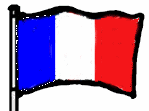 CLEF facile des espèces locales des laîches, joncs et graminées version française
CLEF facile des espèces locales des laîches, joncs et graminées version française
LET'S BEGIN!
|
Either:-
|
|
Flowers like normal flowers
|
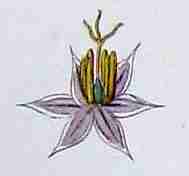
|
2 x 3 tepals; 1 or 2 x 3 stamens; 3 stigmas
Flowers in clusters (inflorescences), with
small individual 'classic' flowers.
Leaves may be grass-like straps, or tubular.
|
|
or:-
|
|
Plants grass-like, with no obvious petal
structure
|
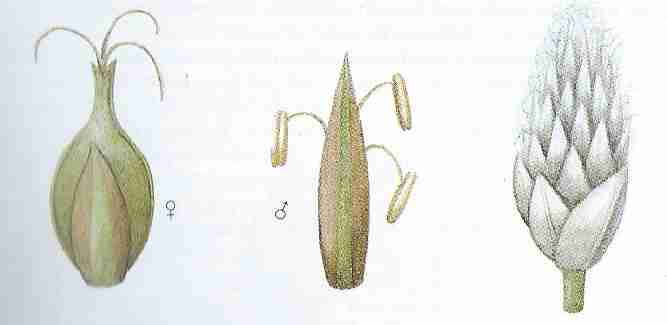
|
Each flower has no petals, no perianth (except some with
bristly perianth becoming silky in fruit).
Most (Carex species) have a single flower subtended by a single glume (bract), making a spikelet. These are grouped into spikes.
Other genera have a several flowers subtended by a single glume (bract), making a spikelet. These spikelets may be solitary or grouped into spikes.
Stem usually triangular.
|
|
or:-
|
POACEAE—GRASS FAMILY
|
Plants grass-like, rather unsurprisingly, with no obvious petal
structure
|
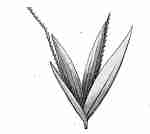
|
Flowers grouped in a spikelet; spikelets grouped in a spike = the inflorescence
Each flower has no petals, no perianth
Small group of flowers, (or more rarely a single flower) grouped in a spikelet, subtended by two glumes (bracts), each flower perhaps
extended into an awn.
Stem usually round.
|
Return to choose family
JUNCACEAE—RUSH FAMILY
Flowers like normal flowers 2
x 3 tepals; 1 or 2 x 3 stamens; 3 stigmas.
2
x 3 tepals; 1 or 2 x 3 stamens; 3 stigmas.
Leaves may be grass-like straps, or tubular. Flowers in clusters
(inflorescences) with small individual flowers.
Juncaceae - the RUSH family (species Juncus and Luzula)
|
Flowers like normal flowers
|

|
Petals and sepals small, and similar
|
|
|
|
|
|
|
Either:-
|
Juncus species
|

|
leaves hairless, many seeds
|
|
|
|
|
|
or:-
|
Luzula species
|
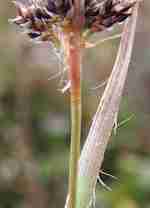
|
Hairy along stem, at least at base
|
|
|
|
|
Juncus species of the Juncaceae family
Leaves hariless
Juncus species - RUSHES
|
Juncus species
|

|
leaves hairless, many seeds. Single cluster of flowers per stem. Leaf
may be tubular or grass-like. Grows as a cluster, or along rhizomes
|
Check: Texture of stem (pith, corrugated) and leaves
(compartments). Clump or rhizome. Height of tepals/fruit. Seeds.
|
|
|
|
|
|
Either:-
|
Inflorescence appears below stem tip (‘bract’ above, which is
a stem-like leaf)
|
4 species in the Cévennes. Start with Juncus inflexus
|

|
Also Juncus effusus, Juncus conglomeratus, Juncus
filiformis
|
|
|
|
|
or:-
|
Inflorescence at stem tip
|
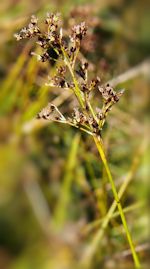
|
|
|
|
|
|
|
|
Either:-
(Inflorescence at stem tip)
|
Leaves compartmented across blade (feel with fingers)
|
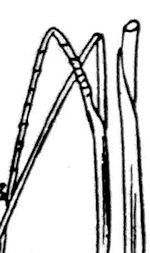
|
5 species in the Cévennes. Start with Juncus articulatus
|
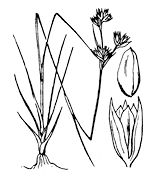
|
Also Juncus alpino-articulatus, Juncus acutiflorus, Juncus
striatus, Juncus pygmaeus (also next group, as compartments not
always obvious)
|
|
|
|
or:-
(Inflorescence at stem tip)
|
Leaves not compartmented, tubular
|
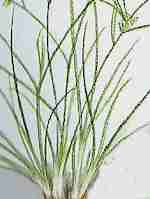
|
2 species in the Cévennes. Start with Juncus pygmaeus
|
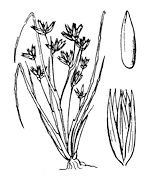 (also in previous group, as
leaves slightly knotty) (also in previous group, as
leaves slightly knotty)
|
Also Juncus bulbosus
|
|
|
or:-
(Inflorescence at stem tip)
|
Leaves not compartmented, blade flat or with canal
|
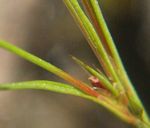
|
7 species in the Cévennes. Start with Juncus squarrosus
|
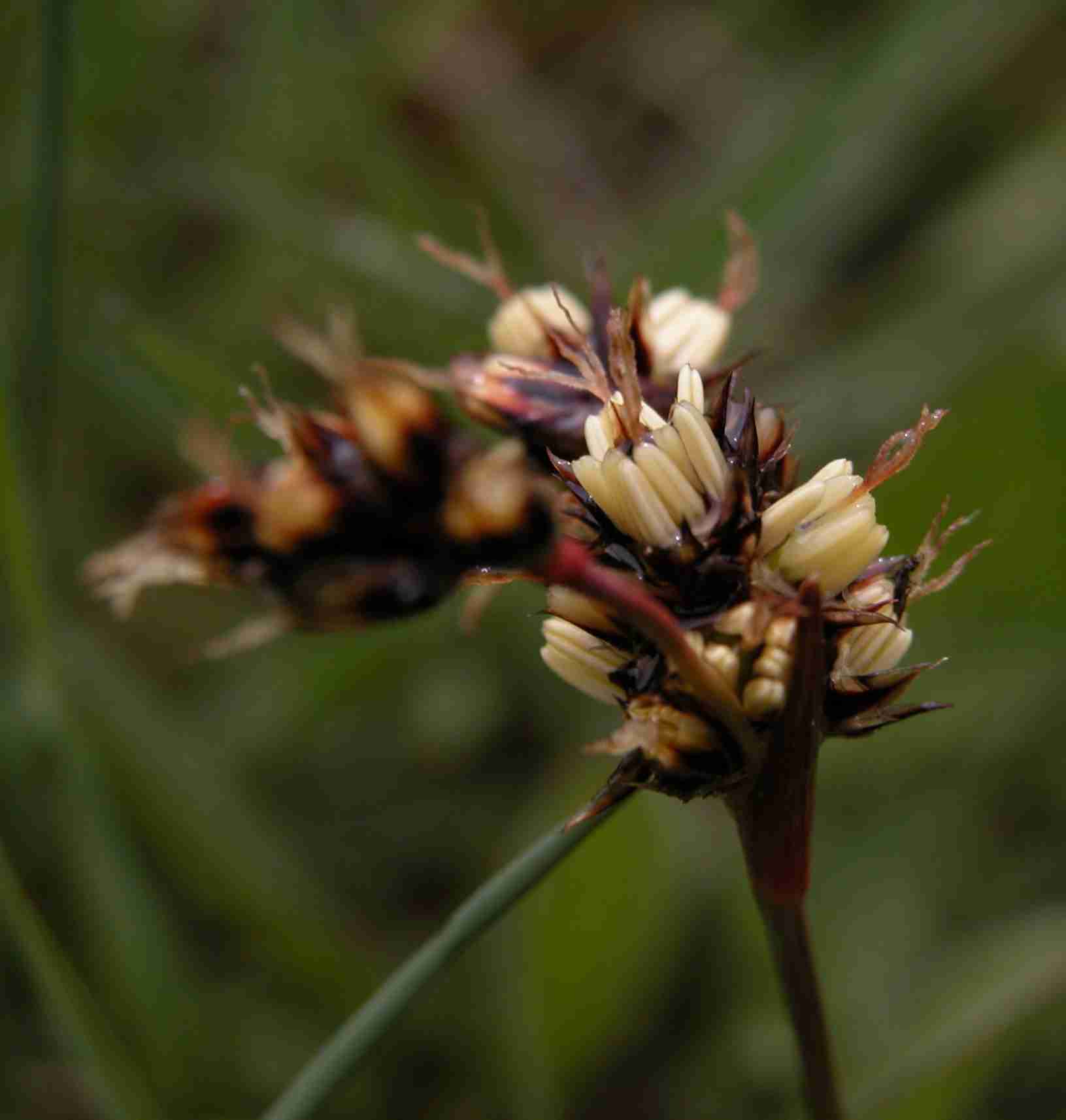
|
Also Juncus compressus, Juncus trifidus, Juncus tenuis, Juncus
capitatus, Juncus bufonius, Juncus tenageia
|
Return to rush
family
or
Start again
Luzula species of the Juncaceae family
Leaves hairy (at least at base). Few seeds, with a food store (called an
'elaiosome') attached for ants
—
Luzula species - WOODRUSHES
|
Luzula Hairy along stem.
|
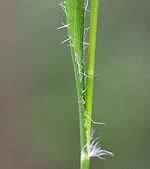
|
Check: Colour of tepals. Seeds for elaiosome and general
shape.
|
|
|
|
|
|
|
Either:-
|
Each individual flower has a long stalk. Seeds with elaiosome 0.6mm
|
3 species in the Cévennes. Start with Luzula forsteri
|
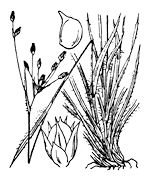
|
Also Luzula luzulina, Luzula pilosa
|
|
|
|
|
or:-
|
Individual flowers do not have own stalk
|
|
|
|
|
|
|
|
Either:-
|
Flowers remain whitish or reddish as they fade, branched glomeruli
(flower clusters), entire leaf hairy
|
3 species in the Cévennes. Start with Luzula nivea
|
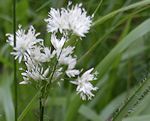
|
Also Luzula luzuloides, Luzula sylvatica (also next group,
as variable)
|
|
|
|
or:-
|
Flowers dark brown as they fade, small glomeruli, no eliaosome
|
2 species in the Cévennes. Start with Luzula sylvatica (also
previous group, as variable)
|
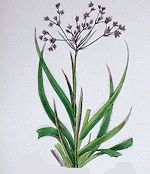
|
Also Luzula desvauxii
|
|
|
|
or:-
|
Flowers dark brown as they fade, large glomeruli, obvious eliaosome
|
5 species in the Cévennes. Start with Luzula campestris
|

|
Also Luzula multiflora, Luzula congesta, Luzula sudetica,
Luzula spicata
|
|
Return to all
Luzula
or Return to Juncaceae family
or Start again
CYPERACEAE—SEDGE FAMILY– FAMILLE DES LAICHES
Plants grass-like, with no obvious petal structure
Each flower has no petals, no perianth (except some with
bristly perianth becoming silky in fruit e.g. Eriophorum).
Most (Carex species) have a single flower subtended by a single glume (bract), making a spikelet. These are grouped into spikes.
Other genera have a several flowers subtended by a single glume (bract), making a spikelet. These spikelets may be solitary or branched or grouped into spikes.
Leaves often reduced to sheaths, mostly triangular stems.
Each flower is either just 1-3 stamens, or ovary with 2-3 styles, or both
Cyperaceae - the SEDGE family (main species Carex,
Eriophorum and Eleocharis)
|
Plants grass-like, with no obvious petal structure
|

|
No petals, no perianth (except some with bristly perianth becoming
silky in fruit)
|
|
|
|
|
|
|
Either:-
|
Carex - true sedges.
Each individual flower (spikelet) is either male or female. Spikelets
grouped into spikes on separate areas of same stalk,
or rarely male and female spikes on different stalks.
Triangular stem. 53 species of this genus in Cévennes National Park
|
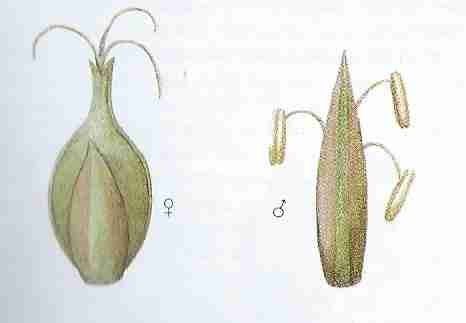 see
'True sedges' table see
'True sedges' table
|
|
|
|
|
|
|
or:-
|
Not true sedges Male and female parts together in each
spikelet. Spikelet contains a group of flowers, often tightly
grouped as an inflorescence at the stem tip
|
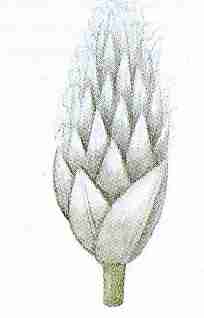 See 'not
true sedges' table See 'not
true sedges' table
|
|
|
|
|
|
Return to all species in
the sedge family (Cyperaceae)
-
or Start again
True sedges - Carex species of the Cyperaceae family
Warning: sedges can be very variable, and several plants must be examined
to determine typical features. Thus one photo may be misleading.
For full identification of many species, the flower and the seed
structure is needed, but this key should help narrow the field.
True sedges - Carex species.
|
Carex
|
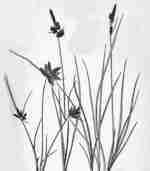
|
Each individual flower (spikelet) is either male or female. Spikelets
grouped into spikes on separate areas of same stalk,
or rarely male and female spikes on different stalks
|
Check: sex of each spikelet (flower) within
the spike (inflorescence)
|
|
|
Either:-
|
Spikes dissimilar, with distinctive separate male and female spikes
along stem
|
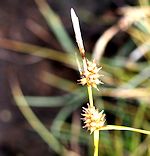
|
see 'Carex: Separate male and female
spikes'
|
|
|
or:-
|
Spikes all similar along stem, with male and female flowers on same spikes along
multi-spike stem
|
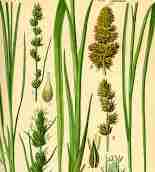
|
see 'Carex: several spikes along stem with combination of male
and female flowers'
|
|
or:-
|
Single spike on stem, usually unisex, occasionally male and female
|
1 species in the Cévennes Carex davalliana
|
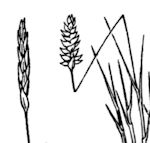
|
Return to all Carex
species
-
Return to all species in the sedge family
(Cyperaceae)
-
or Start again
Carex: Separate male and female spikes
|
Carex: 1 of 2 sub-groups
|
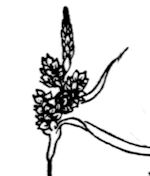
|
Spikes dissimilar, with distinctive male and female spikes along stem
|
Check: Do most spikes overlap, especially the male and top
female spikes?
Note: very variable, examine several spikes
|
|
|
Either:-
|
(most) spikes overlapping, clustered together at tip
|
9 species in the Cévennes. Start with Carex flava
|
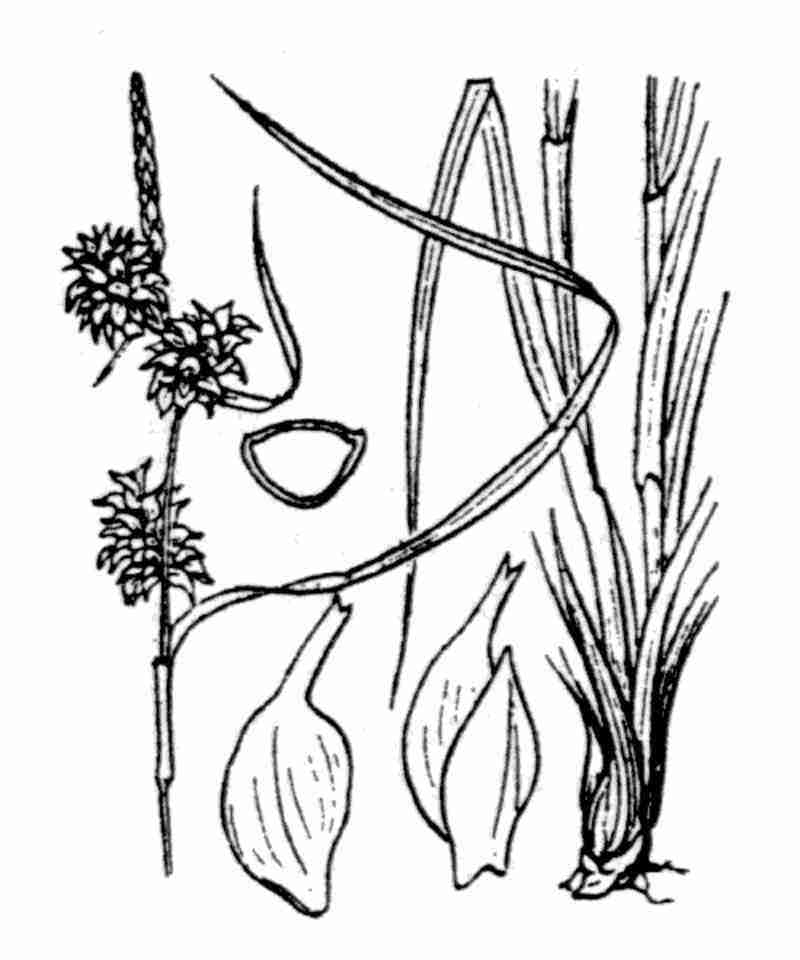
|
Also Carex umbrosa, Carex tomerntosa,Carex lepidocarpa,
Carex mairei and in drier areas, Carex pilulifera, Carex
caryophyllea, Carex pallescens, Carex montana
|
|
or:-
|
Spikes not overlapping
One male spike (or a tiny 2nd), females on peduncles. Often in dryish
or woodland areas.
|
14 species in the Cévennes. Start with Carex liparocarpos
|
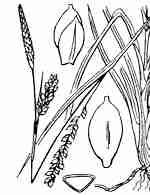
|
Also Carex halleriana, Carex sylvatica, Carex digitata, Carex
frigida, Carex panicea, Carex distans, Carex alba, Carex
olbiensis, Carex depauperata, Carex depressa subsp. basilaris, Carex
limosa, Carex punctata, Carex strigosa
|
|
or:-
|
Spikes not overlapping
one male spike (or a tiny 2nd), females not on peduncles (except
perhaps lowest)
|
8 species in the Cévennes. Start with Carex humilis
|
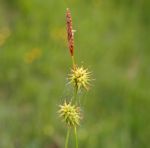
|
Also Carex otrubae, Carex pendula (variable no. of male
spikes) , Carex demissa, Carex hostiana, Carex ornithopoda.
Carex brachystachys
|
|
or:-
|
Spikes not overlapping
male spikes more than 1 (usually)
|
8 species in the Cévennes. Start with Carex nigra
|
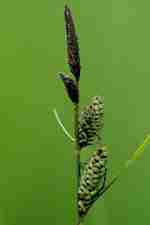
|
Also Carex rostrata, Carex vesicaria, Carex flacca, Carex
hirta, Carex acuta, Carex riparia, Carex acutiformis
|
Return to all Carex
species
-
Return to all species in the sedge family
(Cyperaceae)
-
or Start again
Carex: several spikes along stem with combination of male and female flowers
|
Carex: 2 of 2 sub-groups
|
Spikes not clearly differentiated into male spikes and female spikes
|

|
|
|
|
|
Either:-
|
spikes all similar, with individual male and female flowers on single
spike on stem
|
3 species in the Cévennes. Start with Carex pulicaris
|
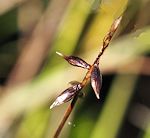
|
Also Carex oedipostyla, Carex pauciflora
|
|
or:-
|
spikes all similar, with male and female flowers on same spikes along
multi-spike stem
|
|
|
|
|
|
If multi-spike stem,either:-
|
spikes usually stalkless, and overlapping in a dense roundish
inflorescence at tip of stem
|
9 species in the Cévennes. Start with Carex echinata
|
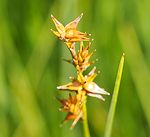
|
Also Carex paniculata, Carex canescens, Carex distachya, Carex
pairae, Carex spicata, Carex leporina, Carex vulpina, Carex
disticha
|
|
|
If multi-spike stem,or:-
|
spikes usually stalkless, but not overlapping in a lax inflorescence;
or lower spikes stalked
|
1 species in the Cévennes. Start with Carex divulsa
|
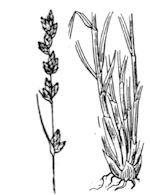
|
Also Carex remota
|
Return to all Carex
species
or
Return to all species in the sedge family
(Cyperaceae)
-
or Start again
Sedge family but not true sedges (i.e. not Carex spp.)
Male and female parts together in each flower.
Spikelet contains a group of flowers, often tightly grouped as an
inflorescence at the stem tip >
Same family (Cyperaceae) as Carex, but not true sedges
|
Several genera
|

|
Male and female parts together in each spikelet
|
Check: form of spikelet, leafy bracts around inflorescence,
leaves
|
|
|
|
Either:-
|
Glumes in 2 ranks (like barley), all individual flowers bisexual
|
see Cyperus and Schoenus
|
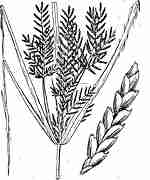
|
|
or:-
|
Glumes in a spiral, all individual flowers bisexual
|
see Eriophorum (cotton grass), Eleocharis and
Scirpus
|
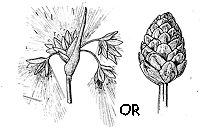
|
Return to all non-Carex species in the
sedge family (Cyperaceae)
or
Return to all species in the sedge family
(Cyperaceae)
-
or Start again
Non-Carex: Male and female flowers together: Glumes in 2 ranks :
|
Cyperus and Schoenus
|

|
Glumes in 2 ranks (like barley), one or several large leaf-like
bracts just below inflorescence
|
|
|
|
|
Either:-
|
Cyperus spp.: - inflorescence with leafy rosette of bracts below.
Triangular stem.
|
4 species in the Cévennes. Start with Cyperus longus
|

|
Also Cyperus badius, Cyperus esculentus, Cyperus eragrositis
|
|
or:-
|
Schoenus spp.: clustered inflorescence of 5-20 spikelets of 1-4
flowers, with l tall bract, 1 small below. Round stem
|
1 species in the Cévennes. Schoenus nigricans
|
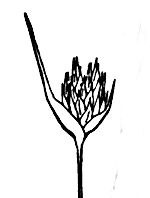
|
|
Return to all non-Carex species in the
sedge family (Cyperaceae)
-
Return to all species in the sedge family
(Cyperaceae)
-
or Start again
Non-Carex: Male and female flowers together: Glumes in a spiral:
|
Eriophorum, Eleocharis and Scirpus types
|

|
Perianth of bristles (effectively the remnants of petals/sepals),
which often elongate considerably to surround the fruit
|
|
|
|
|
Either:-
|
Eriophorum spp.
|
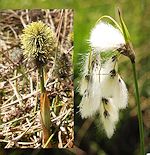
|
Perianth of bristles which become long cottony threads in fruit.
Tendency for triangular tip to stems
|
4 species in the Cévennes. Start with Eriophorum
angustifolium
|
Also Eriophorum latifolium, Eriophorum vaginatum, Eriophorum
gracile
|
|
or:-
|
Eleocaris spp.
|
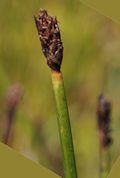
|
Single round stem, leaf reduced to sheath, and compressed terminal
inflorescence. Perianth -> bristly silks in fruit
|
6 species in the Cévennes. Start with Eleocharis palustris
|
Also Eleocharis quinquiflora, Eleocharis acicularis, Eleocharis
ovata, Eleocharis multicaulis, Eleocharis uniglumis
|
|
or:-
|
Rhynchospora spp.
|
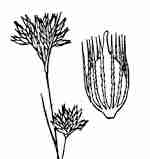
|
Clustered inflorescence of white flowers. Triangular stem.
|
1 species in the Cévennes. Rhynchospora alba
|
|
|
or:-
|
Scirpus and similar species
|
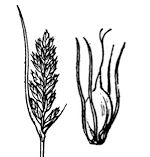
|
Inflorescence subtended by tall ‘leaf blade’ (bract), mostly with
bristles that become silky in fruit (previously all ‘Scirpus’
spp.)
|
5 species in the Cévennes. Choose from those
below
|
|
|
|
Either:-
|
(Scirpus type with single tall bract)
|
Loose drooping much-branched terminal inflorescence with leaf-like
bracts, perianth of bristles which remain fairly short in fruit.
Triangular stems.
|
Scirpus sylvaticus
|
|
|
|
or:-
|
(Scirpus type with single tall bract)
|
Tall, tight clustered terminal inflorescences, with very tall
leaf-like bract, no bristles. Round stems.
|
Scirpoides
holoschoenus
|
|
|
|
or:-
|
(Scirpus type with single tall bract)
|
Like Scirpoides, but tiny. Round stems.
|
Isolepis setacea
|
|
|
|
or:-
|
(Scirpus type with single tall bract)
|
Like Isolepis, but taller spikes, stems with triangular tips perianth
-> silky bristles around fruit
|
Blysmus compressus
|
|
|
|
or:-
|
(Scirpus type with single tall bract)
|
Like Eleocaris, with single stem and compressed terminal
inflorescence , but has 1 small leaf, silky bristles around fruit.
Round stem.
|
Trichophorum
cespitosum
|
|
Return to all non-Carex species in the sedge
family (Cyperaceae)
-
Return to all species in the sedge family
(Cyperaceae)
-
or Start again
THE END - I do hope you found what you were looking for
This site is maintained by DAVID DICKENSON of NATURESCENE © 2015 onwards
















 see
'True sedges' table
see
'True sedges' table See 'not
true sedges' table
See 'not
true sedges' table


















